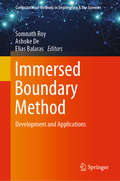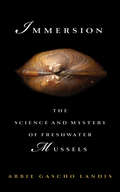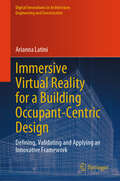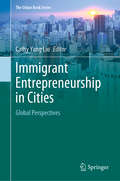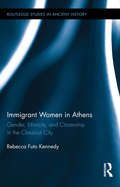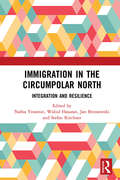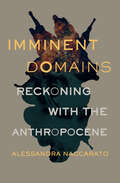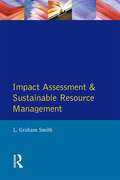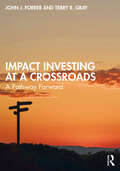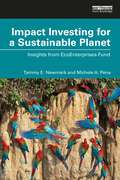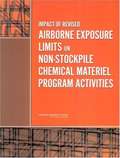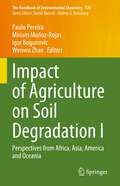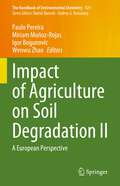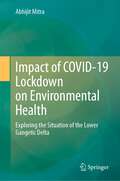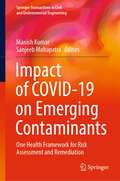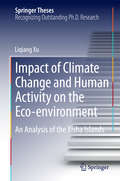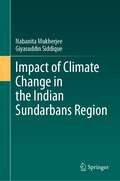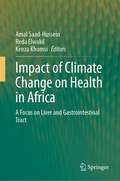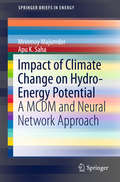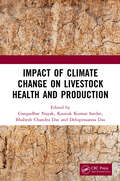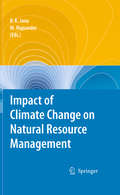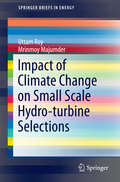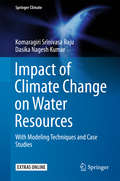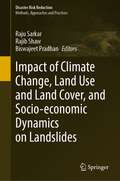- Table View
- List View
Immersed Boundary Method: Development and Applications (Computational Methods in Engineering & the Sciences)
by Ashoke De Somnath Roy Elias BalarasThis volume presents the emerging applications of immersed boundary (IB) methods in computational mechanics and complex CFD calculations. It discusses formulations of different IB implementations and also demonstrates applications of these methods in a wide range of problems. It will be of special value to researchers and engineers as well as graduate students working on immersed boundary methods, specifically on recent developments and applications. The book can also be used as a supplementary textbook in advanced courses in computational fluid dynamics.
Immersion: The Science and Mystery of Freshwater Mussels
by Abbie Gascho LandisAbbie Gascho Landis first fell for freshwater mussels while submerged in an Alabama creek, her pregnant belly squeezed into a wetsuit. After an hour of fruitless scanning, a mussel materialized from the rocks—a little spectaclecase, herself pregnant, filtering the river water through a delicate body while her gills bulged with offspring. In that moment of connection, Landis became a mussel groupie, obsessed with learning more about the creatures' hidden lives. She isn't the only fanatic; the shy mollusks, so vital to the health of rivers around the world, have a way of inspiring unusual devotion.In Immersion: The Science and Mystery of Freshwater Mussels, Landis brings readers to a hotbed of mussel diversity, the American Southeast, to seek mussels where they eat, procreate, and, too often, perish. Accompanied often by her husband, a mussel scientist, and her young children, she learned to see mussels on the creekbed, to tell a spectaclecase from a pigtoe, and to worry what vanishing mussels—70 percent of North American species are imperiled—will mean for humans and wildlife alike. In Immersion, Landis shares this journey, traveling from perilous river surveys to dry streambeds and into laboratories where endangered mussels are raised one precious life at a time.Mussels have much to teach us about the health of our watersheds if we step into the creek and take a closer look at their lives. In the tradition of writers like Terry Tempest Williams and Sy Montgomery, Landis gracefully chronicles these untold stories with a veterinarian's careful eye and the curiosity of a naturalist. In turns joyful and sobering, Immersion is an invitation to see rivers from a mussel's perspective, a celebration of the wild lives visible to those who learn to search.
Immersive Virtual Reality for a Building Occupant-Centric Design: Defining, Validating and Applying an Innovative Framework (Digital Innovations in Architecture, Engineering and Construction)
by Arianna LatiniThis book discusses the cutting-edge intersection of Immersive Virtual Reality (IVR) and research on building occupants. It presents an innovative way of using IVR to revolutionise the comprehension of human-dimension responses to indoor built environments. A robust, innovative, and sequential protocol is defined and validated with a Virtual Environment against a real-world counterpart to provide readers with methodological approaches suitable for carrying out rigorous experimental research in building occupant research. This comprehensive guide provides also practical applications of the proposed guidelines to show the potential and effectiveness of IVR for conducting studies in different indoor environmental conditions in a multi-sensory approach. The book serves as a resource for researchers who want to exploit the full potential of VR in collecting reliable data useful for understanding human dimensions within built environments.
Immigrant Entrepreneurship in Cities: Global Perspectives (The Urban Book Series)
by Cathy Yang LiuThis book draws on evidence from global cities around the world and explores various dimensions of immigrant entrepreneurship and urban development. It provides a substantive contribution to the existing literature in several ways. First of all, it pursues a comparative approach, with case studies from both the global north and global south, so as to broaden the theoretical framework in this area especially as pertinent to emerging economies. Second, it covers multiple scales, from local community place-making, to urban contexts of reception, to transnational networks and connections. Third, it combines approaches and research methods from numerous disciplines, investigating entry dynamics, trends and patterns, business performance, challenges, and the impact of immigrant entrepreneurship in urban areas. Finally, it pays particular attention to current international experiences regarding urban policies on immigrant entrepreneurship. Given its scope, the book will be an enlightening read for anyone interested in immigration, entrepreneurship and urban development issues around the globe.As global cities around the world continue to attract both domestic migrants and international migrants to their bustling metropolises, immigrant entrepreneurship is emerging as an important urban phenomenon that calls for careful examination. From Chinatown in New York, to Silicon Valley in San Francisco, to Little Africa in Guangzhou, immigrant-owned businesses are not only changing the business landscape in their host communities, but also transforming the spatial, economic, social, and cultural dynamics of cities and regions.
Immigrant Women in Athens: Gender, Ethnicity, and Citizenship in the Classical City (Routledge Studies in Ancient History)
by Rebecca Futo KennedyMany of the women whose names are known to history from Classical Athens were metics or immigrants, linked in the literature with assumptions of being ‘sexually exploitable.’ Despite recent scholarship on women in Athens beyond notions of the ‘citizen wife’ and the ‘common prostitute,’ the scholarship on women, both citizen and foreign, is focused almost exclusively on women in the reproductive and sexual economy of the city. This book examines the position of metic women in Classical Athens, to understand the social and economic role of metic women in the city, beyond the sexual labor market. This book contributes to two important aspects of the history of life in 5th century Athens: it explores our knowledge of metics, a little-researched group, and contributes to the study if women in antiquity, which has traditionally divided women socially between citizen-wives and everyone else. This tradition has wrongly situated metic women, because they could not legally be wives, as some variety of whores. Author Rebecca Kennedy critiques the traditional approach to the study of women through an examination of primary literature on non-citizen women in the Classical period. She then constructs new approaches to the study of metic women in Classical Athens that fit the evidence and open up further paths for exploration. This leading-edge volume advances the study of women beyond their sexual status and breaks down the ideological constraints that both Victorians and feminist scholars reacting to them have historically relied upon throughout the study of women in antiquity.
Immigration in the Circumpolar North: Integration and Resilience
by Nafisa YeasminImmigration in the Circumpolar North: Integration and Resilience explores interconnected issues of integration and resilience among both immigrants and host communities in the Arctic region. It examines the factors that inhibit or enable the success of immigrants to the Arctic and the role of territoriality in the process of integration This book showcases a variety of perspectives on circumpolar immigration, and includes insights from eight Arctic countries as well as thirteen ‘observer countries’ such as China, India, Singapore, Poland, Germany, France and Japan. It considers the solidarities and engagements of indigenous and other local peoples with the new coming immigrants and refugees, and the impact of immigration on the economic and societal life in the Circumpolar Arctic. The book will be of interest to researchers, teachers, professors, policymakers and others interested in migration issues, Arctic issues, international relations, law, and economic integration.
Imminent Domains: Reckoning with the Anthropocene
by Alessandra NaccaratoImminent Domains: Reckoning with the Anthropocene invites readers to join a contemplation of survival—our own, and that of the elements that surround us. Using research, lyric prose, and first-hand experiences, Alessandra Naccarato addresses fundamental questions about our modern relationship to nature amidst depictions of landscapes undergoing dramatic transformation.We trace the veins of harm, memory and meaning amongst ecosystems and bioregions; through history and across continents, from the mines of Cerro Rico to the ruins of Pompeii. Arranged by five central elements of survival—earth, fire, water, air and spirit—these essays refute linearity, just as nature does.Naccarato offers not blanket answers about our future, but rather myriad ways to find our own, individual response to an imminent question. We are being called to work together; to dig a trench deep and wide enough that the fires around us might stay at bay. How do we turn towards the fire?
Impact Assessment and Sustainable Resource Management (Themes In Resource Management)
by L Graham SmithFirmly places impact assessment in the broader context of environmental planning, developing a much-needed integrative approach. The topics covered include: decision making and dispute resolution; the role of environmental law; public policy, administration and publication participation; the nature of planning; impact assessment methodology; the application of impact assessment to frontier developments; linear facilities and waste mana
Impact Cratering: Processes and Products
by E. Pierazzo G. R. OsinskiImpact cratering is arguably the most ubiquitous geological process in the Solar System. It has played an important role in Earth’s history, shaping the geological landscape, affecting the evolution of life, and generating economic resources. However, it was only in the latter half of the 20th century that the importance of impact cratering as a geological process was recognized and only during the past couple of decades that the study of meteorite impact structures has moved into the mainstream. This book seeks to fill a critical gap in the literature by providing an overview text covering broad aspects of the impact cratering process and aimed at graduate students, professionals and researchers alike. It introduces readers to the threat and nature of impactors, the impact cratering process, the products, and the effects – both destructive and beneficial. A series of chapters on the various techniques used to study impact craters provide a foundation for anyone studying impact craters for the first time.
Impact Investing at a Crossroads: A Pathway Forward
by John Forrer Terry GrayThere is no questioning the enthusiasm that welcomed impact investing as an alternative approach to making investments: Take account of both financial returns and the social and environmental impacts. But there is no denying that the approach has fallen well short of expectations.Impact investing has shown great promise as a major transformational investment paradigm, but in practice under-performing woefully and its prospects are dimming: It comprises less than 1% of the world’s equity investments, and too many claims of success are more about marketing and reputational value than hard evidence of positive social impacts. Drawing on over a decade of hands-on experience, this book presents a unique combination of a how-to guide and a reimagining – new models, frameworks, techniques, and tools – of what impact investing could be and could accomplish. It points to a new direction for future impact investments: achieve higher financial returns, more positive social and environmental impacts, and lower risks than conventional investments. Readers will learn what actions should be taken at each stage of impact investing, and which models, analytic frameworks, and techniques to use – and how to use them – for optimal results.This book offers a step-by-step guide to how impact investing can achieve its promise of transforming global investments into a powerful positive force for change. It is an inspiring and comprehensive resource for anyone who wants to understand how impact investing works and how it can be done better, from professionals at foundations, international NGOs, consulting firms, and government agencies, to students of finance, public policy, ESG, sustainability and international development.
Impact Investing for a Sustainable Planet: Insights from EcoEnterprises Fund
by Tammy E. Newmark Michele A. PenaImpact Investing for a Sustainable Planet guides investors in supporting entrepreneurs to scale business models which maximize positive impact outcomes, including climate- and nature-based solutions. EcoEnterprises Fund is a long-standing leader in the impact investing industry, which helps advance sustainable entrepreneurial ventures and promote environmental stewardship in Latin America. Following on from their previous book, Portfolio for the Planet, Tammy E. Newmark and Michele A. Pena take stock of EcoEnterprises Fund’s processes and partnerships over two decades and three impact funds. They detail the unique strategies employed by the Fund to invest in expanding sectors such as regenerative agriculture, agroforestry, bio-innovation, and climate tech. Close analysis of the investment processes and company engagements offers practical takeaways, ranging from tips on structuring transactions to guidance on enhancing companies’ environmental and social management systems and community partnerships. These case studies highlight how specific themes – including biodiversity investing, supply chain management, gender-smart investing, climate solutions, and successful exits – form the basis for sustainable growth and enduring powerful outcomes. This inspiring volume offers practical advice for veterans and newcomers in the field of impact investing. It will also be a valuable resource for students and scholars of sustainable investing and finance, social entrepreneurship, and sustainable business.
Impact Of Revised Airborne Exposure Limits On Non-stockpile Chemical Materiel Program Activities
by National Research Council of the National AcademiesThe U.S. Army’s Non-Stockpile Chemical Materiel program is responsible for dismantling former chemical agent production facilities and destroying recovered chemical materiel. In response to congressional requirements, the Center for Disease Control (CDC), in 2003, recommended new airborne exposure limits (AELs) to protect workforce and public health during operations to destroy this materiel. To assist in meeting these recommended limits, the U.S. Army asked the NRC for a review of its implementation plans for destruction of production facilities at the Newport Chemical Depot and the operation of two types of mobile destruction systems. This report presents the results of that review. It provides recommendations on analytical methods, on airborne containment monitoring, on operational procedures, on the applicability of the Resource Conservation and Recovery Act, and on involvement of workers and the public in implementation of the new AELs.
Impact of Agriculture on Soil Degradation I: Perspectives from Africa, Asia, America and Oceania (The Handbook of Environmental Chemistry #120)
by Paulo Pereira Miriam Muñoz-Rojas Igor Bogunovic Wenwu ZhaoThis is the first of two volumes that together provide a global overview of the impact of agriculture on soil degradation, tracing the most critical drivers like the use and abuse of agrochemicals, mechanization, overgrazing, irrigation, slash and burn agriculture, and the use of plastics. This book covers the main effects of agriculture practices on soil degradation in several countries from Africa, America, Asia, and Oceania, and it elucidates the impact of chemical agents on soil quality, namely, the use of fertilizers, herbicides, pesticides, soil acidification and microplastics pollution. In these continents, a large number of the population depend on agriculture, which sets an enormous pressure on the ecosystems. Divided into 13 chapters, the book offers authoritative contributions about the fundamental soil degradation problems in countries such as Argentina, Australia, Peru and Bolivia, Brazil, Chile, China, Colombia, India, Israel, Kenya, Mexico, South Africa, the United States of America. As soil degradation issues are often linked with biodiversity loss and poverty, readers will also find in this book an important discussion of the different social, economic, political, and environmental aspects contributing to soil quality and sustainable management. Given the breadth and depth of its coverage, the book offers an invaluable source of information for researchers, students, environmental managers and policymakers alike.
Impact of Agriculture on Soil Degradation II: A European Perspective (The Handbook of Environmental Chemistry #121)
by Paulo Pereira Miriam Muñoz-Rojas Igor Bogunovic Wenwu ZhaoThis is the second of two volumes that together provide a global overview of the impact of agriculture on soil degradation, tracing the most critical drivers like the use and abuse of agrochemicals, mechanization, overgrazing, irrigation, slash and burn agriculture, and the use of plastics.Soil degradation caused by agriculture practices is a complex issue which depends on the interaction of social, economic, political, and environmental aspects. In this book, expert contributors elucidate the extension of the effects of agriculture on soil degradation in Europe, a continent with different cultures and political backgrounds that affect agricultural practices. Readers will also find in this book authoritative solutions to minimize the effects of agriculture intensification and land-use in this continent. Divided into 12 chapters, the book offers a European perspective on soil quality and sustainable management, including case studies about the impact of chemical agents like fertilizers, herbicides, pesticides, and soil acidification and microplastics pollution in agriculture practices from countries such as Croatia, Czech Republic, Estonia, Latvia and Lithuania, Germany, Portugal and Greece, Hungary, Iceland, Italy, Slovenia, Spain, Sweden, and Ukraine. Given the breadth and depth of its coverage, the book offers an invaluable source of information for researchers, students and environmental managers alike.
Impact of COVID-19 Lockdown on Environmental Health: Exploring the Situation of the Lower Gangetic Delta
by Abhijit MitraThis book examines the impacts that the COVID-19 lockdown has had on environmental and ecological health, with a focus on coastal ecosystems in the Lower Gangetic Delta. The book begins with an overview of COVID-19's spread and impact before and after the lockdown in the focus region, then addresses the specific impacts that the lockdown period had and continues to have on air quality, marine and estuarine water quality, coastal biodiversity, and the livelihoods of the region's inhabitants, especially those who live below the poverty line. The decrease in human activity combined with the complete closure of various sectors, including air travel, oil and gas drilling, and construction, has had a pronounced effect on biodiversity and overall environmental health that is yet to be fully realized. The book sheds light on these changes and assesses how biodiversity, ambient air quality, and ecosystem functioning will progress as COVID-19 remains a threat and the lockdown persists. The study will be of interest to researchers, government officials and professionals dealing with disaster management, environmental science, biological science, and health.
Impact of COVID-19 on Emerging Contaminants: One Health Framework for Risk Assessment and Remediation (Springer Transactions in Civil and Environmental Engineering)
by Manish Kumar Sanjeeb MohapatraThe book brings out several unique perspectives of impacts of COVID-19 on the environment with special emphasis on the risk and remediation of emerging contaminants. Idea is to work out under the one health framework and comprehend not only scientific and technical aspects but also environmental, legal and policy aspects for water resources management. The obvious stress is given to the occurrence, fate and transport of geogenic, microbial and anthropogenic contaminants of emerging concern under the preview of the fact that antibiotic and antiviral use has been unprecedented during the global pandemic of COVID-19. At the same time, this edited volume touches upon the broader framework of integrated water resource management, as well as mitigation and removal strategies to put forward a holistic picture to the readers and policymakers. These contents are divided into three sections: a) monitoring, occurrence, distribution and fate of emerging contaminants; b) source and effects of these contaminants on the total environment; and c) treatment strategies, natural attenuation and mitigation.
Impact of Climate Change and Human Activity on the Eco-environment
by Liqiang XuThis study describes the fundamentals of assessing the vulnerability of coral islands, as well as environmental management and resource exploitation. Using seabird subfossils, such as bones, guano, eggshells etc. , which have been well preserved on the Xisha Islands in the South China Sea, the author identifies the influences of climate change and human activity on seabird populations and diets. Understanding the past is of great importance for predicting the future, and seabird subfossils provide valuable information, which can be used to study changes in seabird ecology, paleoceanography and palaeoclimate. Furthermore, this study proposes examining the biogeochemical cycling of some elements present in the geosphere, hydrosphere, biosphere and atmosphere. Dr. Liqiang Xu works at the Hefei University of Technology, China.
Impact of Climate Change in the Indian Sundarbans Region
by Nabanita Mukherjee Giyasuddin SiddiqueThis book studies climate change vulnerability in the Southern Part of the Indian Sundarbans Region, West Bengal, following the IPCC framework which highlights three prime components of vulnerability - exposure, sensitivity and adaptive capacity. This framework is considered as one of the best methods of vulnerability assessment as it uses direct household perception through collection of primary data, and recognizes a household’s proficiency in maintaining sustainable means of livelihood to deal with climatic changes. This is especially important in gauging the knowledge and perception of local indigenous people on climate change, and determining what measures can be taken to foster informed decision making for improved climate change adaptation and management. The specific impact of climate change on women, their lives and livelihood are also given due attention, as there is little written about gendered vulnerability to climate change in the region. The final chapter elaborates the limits, barriers to adaptation of climate change and also extends site specific suggestions for achieving community resilience in the Indian Sundarbans Region.
Impact of Climate Change on Health in Africa: A Focus on Liver and Gastrointestinal Tract
by Amal Saad-Hussein Reda Elwakil Kenza KhomsiThis book provides detailed information on the impact of climate change on gastrointestinal and liver health and disease patterns on the African continent. It also discusses the adaptation measures required to mitigate these impacts and highlights the complex interplay between climate change and various forms of gut diseases, ranging from the spread of infectious diseases to emerging parasites. This volume is intended for both public health researchers, climate epidemiologists, gastroenterologists, hapatologists, and tropical medicine physicians seeking to develop a comprehensive understanding of the links between climate change and disease patterns in Africa. The ideas and findings covered in this book contribute to UN Sustainable Development Goal 3: Good Health and Well-Being and SDG 13: Climate Action.
Impact of Climate Change on Hydro-Energy Potential
by Mrinmoy Majumder Apu K. SahaThis Brief presents the impact of climatic abnormalities on hydropower potential of different regions of the World. In this regard, multi-criteria decision making and neural network are used to predict the impact of the change cognitively by an index. The results from the study show that the hydro-energy potential of the Asian region is mostly vulnerable with respect to other regions of the World. The model results also encourage further application of the index to analyse the impact of climate change on potential of hydro-energy.
Impact of Climate Change on Livestock Health and Production
by G D Nayak K K Sardar B C Das D P DasThis volume of 30 chapters contributed by reputed authors covers: Diversification of livestock and crops. Integration of livestock systems with forestry and crop production. Drought and heat wave tolerant varieties. Strategies for reduction of Green House Gases emission from ruminants. Application of GIS and remote sensing technologies. Breeds with inherent genetic capabilities to adapt to climate change. This book also takes into account the climate change adaptation, mitigation practices, and policy frameworks for promotion of sustainable livestock and poultry production. This book is co-published with NIPA. Taylor and Francis does not sell or distribute its print and electronic editions in India, Pakistan, Nepal, Bhutan, Bangladesh and Sri Lanka.
Impact of Climate Change on Natural Resource Management
by Mrinmoy Majumder Bipal Kr. JanaAs climate change takes hold, there is an ever-growing need to develop and apply strategies that optimize the use of natural resources, both on land and in water. This book covers a huge range of strategies that can be applied to various sectors, from forests to flood control. Its aim, as with resource management itself, is to combine economics, policy and science to help rehabilitate and preserve our natural resources. Beginning with papers on carbon sequestration, including the practice of artificial desertification, the topics move on to cover the use of distributed modeling and neural networks in estimating water availability and distribution. Further chapters look at uncertainty analysis applied to the spatial variation of hydrologic resources, and finally the book covers attempts at estimating meteorological parameters in the context of hydrological variables such as evapo-transpiration from stream flow. Within the next decade, the effects of climate change will be severe, and felt by ordinary human beings. This book proposes a raft of measures that can mitigate, if not reverse, the impact of global warming on the resources we have all come to depend on.
Impact of Climate Change on Small Scale Hydro-turbine Selections
by Mrinmoy Majumder Uttam RoyHydropower is found to be one of the most reliable and inexpensive options for renewable energy which was now widely been adopted by many countries to substitute fossil fuel sources. This Brief highlights the impact of climate change on hydropower plants, especially on the turbine design, as turbines are responsible for optimal conversion and regular energy production. The vulnerability of turbines is analyzed with the help of Artificial Neural Networks, followed by Multi Criteria Decision Making methods for development of intelligent indices to represent the level of vulnerability of turbines due to the change in climate.
Impact of Climate Change on Water Resources: With Modeling Techniques and Case Studies (Springer Climate)
by Komaragiri Srinivasa Raju Dasika Nagesh KumarThis book gives an overview of various aspects of climate change by integrating global climate models, downscaling approaches, and hydrological models. It also covers themes that help in understanding climate change in a holistic manner. The book includes worked-out examples, revision questions, exercise problems, and case studies, making it relevant for use as a textbook in graduate courses and professional development programs. The book will serve well researchers, students, as well as professionals working in the area of hydroclimatology.
Impact of Climate Change, Land Use and Land Cover, and Socio-economic Dynamics on Landslides (Disaster Risk Reduction)
by Rajib Shaw Biswajeet Pradhan Raju SarkarThis book discusses the impact of climate change, land use and land cover, and socio-economic dynamics on landslides in Asian countries. Scholars recently have brought about a shift in their focus regarding triggering factors for landslides, from rainfall or earthquake to claiming rapid urbanization, extreme population pressure, improper land use planning, illegal hill cutting for settlements and indiscriminate deforestation. This suggests that the occurrence or probabilities of landslides are shaped by both climate-related and non-climate-related anthropogenic factors. Among these issues, land use and land cover change or improper land use planning is one of the key factors. Further climate change shapes the rainfall pattern and intensity in different parts of the world, and consequently rainfall-triggered landslides have increased. These changes cause socio-economic changes. Conversely, socio-economic and lifestyle changes enhance inappropriate land use and climate change. All these changes in land use, climate and socio-economic aspects are dynamics in nature and shape landslide risks in Asian countries, where they are given serious attention by governments, disaster management professionals, researchers and academicians.This book comprises 21 chapters divided into three major sections highlighting the effect of climate change on landslide incidence with the influence on vegetation and socio-economic aspects. The sections address how climate change and extreme events have triggered landslides. The advances in geospatial techniques with the focus on land use and land cover change along with the effect on socio-economic aspects are also explored.
